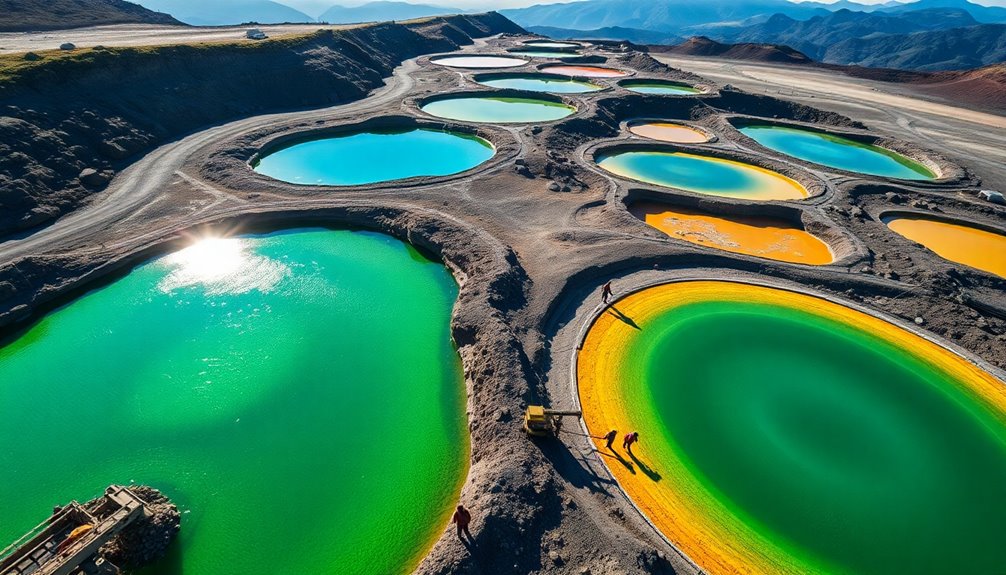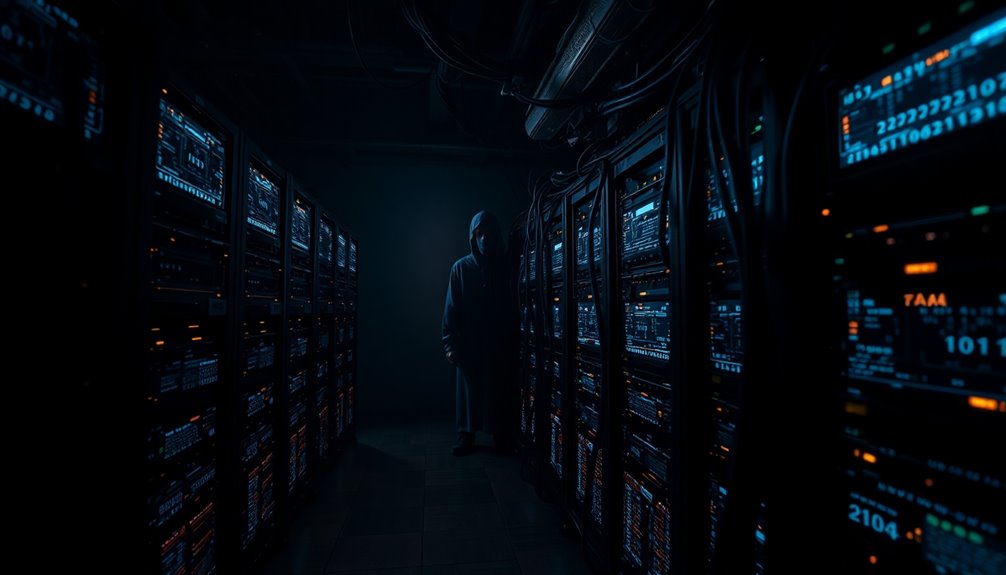A mining pool is a group of miners working together to boost their chances of earning cryptocurrency rewards. By combining your computational power with others, you increase the likelihood of successfully mining blocks and getting paid. Pool operators handle task distribution and reward allocation, ensuring fair compensation based on your contributions. While joining a pool often involves a small fee, it can provide more stable earnings than solo mining. Understanding different distribution methods and security practices can help you choose the right pool. If you're curious about how to maximize your mining success, there's more to explore on this topic.
Key Takeaways
- A mining pool is a collaborative network where miners combine computational power to increase their chances of earning cryptocurrency rewards.
- Pool operators manage the infrastructure, task distribution, and reward allocation based on contributions from participants.
- Rewards are distributed based on processing power and share submissions, using methods like Pay-Per-Share (PPS) or Pay-Per-Last-N-Shares (PPLNS).
- Security is critical in mining pools, emphasizing compliance, regular audits, encryption, and the use of strong passwords for user safety.
- Fees typically range from 1% to 3%, impacting profitability, so comparing fee structures across pools is essential for maximizing earnings.
Mining Pool Overview

Mining pools are collaborative networks where cryptocurrency miners join forces to enhance their chances of earning rewards. In these networks, you connect your mining machine with others, increasing computational power. Pool operators manage the network, ensuring everything runs smoothly and assigning mining duties. As you participate, you submit shares as proof of your efforts, which helps determine your share of the rewards. Mining pools help mitigate the variance in income for individual miners by providing a more stable earning potential.
Rewards are distributed based on the number of shares you submit, with pool operators collecting a fee for their services. By joining a mining pool, you benefit from increased chances of earning rewards, reduced costs, and more consistent payouts compared to mining solo, all while contributing to the security and efficiency of the cryptocurrency network.
Mining Pool Basics Explained

When you join a mining pool, you're tapping into a collective effort that significantly boosts your chances of earning cryptocurrency rewards.
These pools consist of miners connecting their machines to share computational resources. The pool server coordinates this effort, breaking down the mining process into smaller tasks. As a miner, you're assigned specific tasks based on your contributed hash power.
The pool operator manages the infrastructure, distributes tasks, and tracks the shares you submit. They also control reward distribution and adjust difficulty as needed. Mining pools enable collective deployment of computational resources, which increases the frequency and reliability of block creation, making it more likely for participants to receive rewards.
While this collaboration enhances your mining potential, remember that operators charge fees for their services.
Mining Contributions and Rewards

Joining a mining pool means you directly contribute your processing power to a collective effort, significantly increasing your chances of earning rewards.
In this setup, you submit shares of work that represent your contribution to the pool's mining efforts. Pool operators assign specific tasks, managing the overall hash rate for efficiency. Rewards come from your processing power and the number of shares you submit, with pools typically using methods like Pay-Per-Share (PPS) or Pay-Per-Last-N-Shares (PPLNS) for distribution.
Though pools may charge fees between 1% and 3%, these systems ensure you're compensated fairly. Notably, the PPS reward method allows miners to receive payment for every valid share submitted, making it a preferred choice for those seeking immediate rewards.
Pros and Cons

While participating in a mining pool can enhance your chances of earning rewards, it's essential to weigh the pros and cons.
On the upside, mining pools secure the network, increase your chances of consistent payouts, and reduce operational costs, making it easier for smaller miners to compete against larger entities. Additionally, mining pools provide access to advanced mining technology which can further improve efficiency.
However, there are drawbacks. Large pools can centralize control, potentially threatening network security. You'll also face profit-sharing fees, which can eat into your earnings.
Additionally, joining a pool means you'll follow its rules, limiting your autonomy. Lastly, technical issues might lead to lost rewards.
Balancing these factors will help you decide if a mining pool fits your goals.
Mining Pool Types Comparison

Mining pools come in various types, each offering unique payout models, sizes, and supported cryptocurrencies.
You might prefer FPPS for stable earnings, as it includes both block rewards and transaction fees, making pools like Foundry USA and Antpool appealing. Larger pools typically offer stability but may result in smaller individual payouts, so consider your priorities when choosing a mining pool.
If you're okay with fluctuating payouts, consider PPLNS, which rewards you based on recent contributions, used by Braiins Pool.
For a middle ground, PPS+ combines the predictability of PPS with transaction fees, like F2Pool offers.
You'll find larger pools tend to provide frequent payouts, while smaller ones can yield higher rewards per miner.
If you're into diversifying, look for multi-coin support from pools like Antpool, allowing you to mine various cryptocurrencies.
Security Vulnerabilities in Pools

As the popularity of mining pools grows, so do the security vulnerabilities associated with them. You must be aware of malware and cryptojacking, where hackers exploit your devices to mine without your consent.
Insecure network configurations, like default passwords, can leave your setup exposed to attacks. Phishing schemes can trick you into revealing private information or downloading harmful software. Additionally, overheating from extended workloads can damage your hardware. Weak passwords and shared accounts increase the risk of account theft. Centralization can also lead to controlling interests that may censor transactions. To protect yourself, use secure communication protocols, maintain strong passwords, and enable two-factor authentication. Staying vigilant is essential in navigating these vulnerabilities effectively. Moreover, ignoring security policies can lead to significant financial losses for miners.
Decentralized Mining Pool Emergence

Centralized mining pools have raised concerns about transparency and control, leading to a surge in interest for decentralized mining pools.
These pools operate through a peer-to-peer network of miner nodes, allowing you to connect your machine and validate transactions independently. By broadcasting and verifying blocks among nodes, they ensure fair reward distribution.
You'll appreciate the non-custodial payouts that go directly to you, eliminating theft risks by pool operators. Decentralized pools promote transparency, scaling to thousands of miners while minimizing payout variance.
As they align with Bitcoin's core principles, projects like Braidpool are enhancing their attractiveness. Decentralized mining pools aim to overcome the limitations of centralized pools and provide a more equitable system for miners. With increasing support, decentralized mining pools stand as a promising future for maintaining Bitcoin's decentralization amidst concerns of centralized dominance.
Choose Reliable Pool Software

How can you ensure you're using reliable pool software in the ever-evolving landscape of cryptocurrency mining?
Start by assessing the pool's reputation and trustworthiness. Look for established names like Braiins Pool or Antpool, which have proven their reliability over the years. Check user reviews and community feedback to gauge experiences. Mining pools provide access to software experts for personalized assistance and tailored results based on filters like platform, region, and integrations.
Security is crucial, so choose pools like Foundry USA Pool that emphasize compliance and certifications. Analyze the fee structure; pools like Clover Pool offer competitive rates.
Pay attention to uptime performance and server locations to minimize latency. Finally, prioritize user-friendly interfaces and responsive customer support to enhance your mining experience.
With these factors in mind, you'll be well-equipped to choose the right pool software.
Frequently Asked Questions
How Do I Choose the Right Mining Pool for My Needs?
Choosing the right mining pool for your needs involves several key factors.
Start by researching user reviews and community feedback to gauge trustworthiness.
Analyze the pool's fee structure, payout models, and withdrawal thresholds.
Pay attention to uptime and server locations for consistent performance.
Consider the pool's size and principles, aligning them with your goals.
Lastly, ensure it supports the cryptocurrencies you're interested in mining for a more tailored experience.
What Is the Minimum Contribution Required to Join a Mining Pool?
When you're looking to dip your toes into mining pools, the minimum contribution often sets the stage.
Typically, this amount varies, but you might find it around a certain cryptocurrency value, like 0.005 BTC.
If you don't reach that threshold within a day, your earnings take a brief pause until you do.
Can I Switch Mining Pools Easily?
Yes, you can switch mining pools easily.
With tools like Foreman or Minerstat, you can quickly change between pools using a single dashboard or automate profit switching based on rewards. Just save the stratum addresses and configure your wallets for each pool.
If you choose to switch manually, simply select your workers, enter your hashrate, and activate the profit switch.
This flexibility helps you maximize your mining profits efficiently.
What Happens if a Mining Pool Shuts Down?
When a mining pool shuts down, you face immediate challenges.
You'll need to relocate to another pool quickly, or your operations will stop. You might experience temporary disruptions, and if you don't switch in time, you risk losing rewards.
The overall network's hashrate decreases, impacting efficiency and security. Financial losses can occur if the new pool has different rewards, so acting fast is crucial for maintaining profitability and stability in your mining efforts.
Are There Fees Associated With Joining a Mining Pool?
Yes, there're fees associated with joining a mining pool.
These fees typically range from 1% to 4%, depending on the pool and payout model you choose. Higher fees can impact your profitability, especially if you're a smaller miner.
However, some pools justify their fees by offering more consistent payouts or additional services.
It's essential to compare different pools and their fee structures to find the one that best fits your mining strategy.
Conclusion
In the vast ocean of cryptocurrency, mining pools are your sturdy lifeboats, guiding you through turbulent waters. By joining one, you're not just casting your net; you're pooling resources and sharing rewards, navigating the complexities together. While there are waves of pros and cons to consider, the right choice can steer you toward a treasure trove of success. So, choose wisely and embrace the community, for in unity lies strength, and in strength, fortune awaits.









